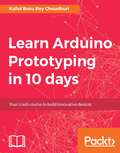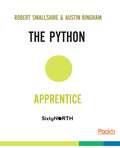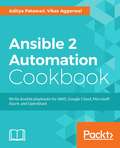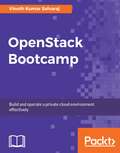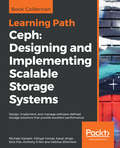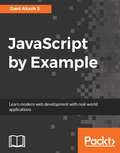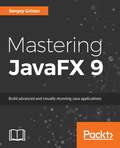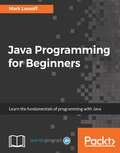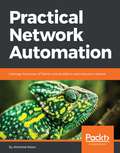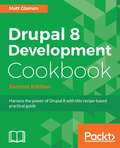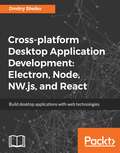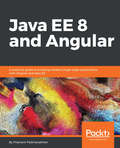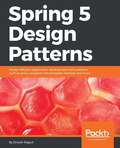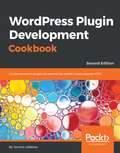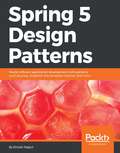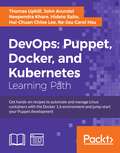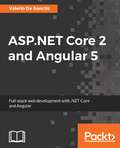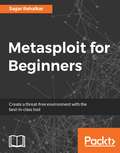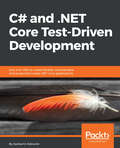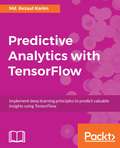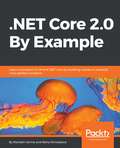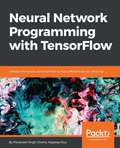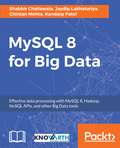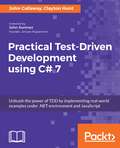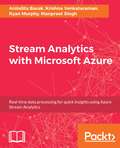- Table View
- List View
Learn Arduino Prototyping in 10 days
by Kallol Bosu ChoudhuriThe ultimate power-packed crash course in building Arduino-based projects in just 10 days! About This Book • A carefully designed 10-day crash course, covering major project/device types, with 20+ unique hands-on examples • Get easy-to-understand explanations of basic electronics fundamentals and commonly used C sketch functions • This step-by-step guide with 90+ diagrams and 50+ important tips will help you become completely self-reliant and confident Who This Book Is For This book is a beginner's crash course for professionals, hobbyists, and students who are tech savvy, have a basic level of C programming knowledge, and basic familiarity with electronics, be it for embedded systems or the Internet of Things. What You Will Learn • Write Arduino sketches and understand the fundamentals of building prototype circuits using basic electronic components, such as resistors, transistors, and diodes • Build simple, compound, and standalone devices with auxiliary storage (SD card), a DC battery, and AC power supplies • Deal with basic sensors and interface sensor modules by using sensor datasheets • Discover the fundamental techniques of prototyping with actuators • Build remote-controlled devices with infrared (IR), radio frequency (RF), and telephony with GSM • Learn IoT edge device prototyping (using ESP8266) and IoT cloud configuration In Detail This book is a quick, 10-day crash course that will help you become well acquainted with the Arduino platform. The primary focus is to empower you to use the Arduino platform by applying basic fundamental principles. You will be able to apply these principles to build almost any type of physical device. The projects you will work through in this book are self-contained micro-controller projects, interfacing with single peripheral devices (such as sensors), building compound devices (multiple devices in a single setup), prototyping standalone devices (powered from independent power sources), working with actuators (such as DC motors), interfacing with an AC-powered device, wireless devices (with Infrared, Radio Frequency and GSM techniques), and finally implementing the Internet of Things (using the ESP8266 series Wi-Fi chip with an IoT cloud platform). The first half of the book focuses on fundamental techniques and building basic types of device, and the final few chapters will show you how to prototype wireless devices. By the end of this book, you will have become acquainted with the fundamental principles in a pragmatic and scientific manner. You will also be confident enough to take up new device prototyping challenges. Style and approach This step-by- step guide will serve as a quick, 10-day crash course to help you become well acquainted with the Arduino platform.
The Python Apprentice
by Austin Bingham Robert SmallshireLearn the Python skills and culture you need to become a productive member of any Python project. About This Book • Taking a practical approach to studying Python • A clear appreciation of the sequence-oriented parts of Python • Emphasis on the way in which Python code is structured • Learn how to produce bug-free code by using testing tools Who This Book Is For The Python Apprentice is for anyone who wants to start building, creating and contributing towards a Python project. No previous knowledge of Python is required, although at least some familiarity with programming in another language is helpful. What You Will Learn • Learn the language of Python itself • Get a start on the Python standard library • Learn how to integrate 3rd party libraries • Develop libraries on your own • Become familiar with the basics of Python testing In Detail Experienced programmers want to know how to enhance their craft and we want to help them start as apprentices with Python. We know that before mastering Python you need to learn the culture and the tools to become a productive member of any Python project. Our goal with this book is to give you a practical and thorough introduction to Python programming, providing you with the insight and technical craftsmanship you need to be a productive member of any Python project. Python is a big language, and it's not our intention with this book to cover everything there is to know. We just want to make sure that you, as the developer, know the tools, basic idioms and of course the ins and outs of the language, the standard library and other modules to be able to jump into most projects. Style and approach We introduce topics gently and then revisit them on multiple occasions to add the depth required to support your progression as a Python developer. We've worked hard to structure the syllabus to avoid forward references. On only a few occasions do we require you to accept techniques on trust, before explaining them later; where we do, it's to deliberately establish good habits.
Ansible 2 Cloud Automation Cookbook: Write Ansible playbooks for AWS, Google Cloud, Microsoft Azure, and OpenStack
by Aditya Patawari Vikas AggarwalOrchestrate your cloud infrastructure Key Features Recipe-based approach to install and configure cloud resources using Ansible Covers various cloud-related modules and their functionalities Includes deployment of a sample application to the cloud resources that we create Learn the best possible way to manage and automate your cloud infrastructure Book Description Ansible has a large collection of inbuilt modules to manage various cloud resources. The book begins with the concepts needed to safeguard your credentials and explain how you interact with cloud providers to manage resources. Each chapter begins with an introduction and prerequisites to use the right modules to manage a given cloud provider. Learn about Amazon Web Services, Google Cloud, Microsoft Azure, and other providers. Each chapter shows you how to create basic computing resources, which you can then use to deploy an application. Finally, you will be able to deploy a sample application to demonstrate various usage patterns and utilities of resources. What you will learn Use Ansible Vault to protect secrets Understand how Ansible modules interact with cloud providers to manage resources Build cloud-based resources for your application Create resources beyond simple virtual machines Write tasks that can be reused to create resources multiple times Work with self-hosted clouds such as OpenStack and Docker Deploy a multi-tier application on various cloud providers Who this book is for If you are a system administrator, infrastructure engineer, or a DevOps engineer who wants to obtain practical knowledge about Ansible and its cloud deliverables, then this book is for you. Recipes in this book are designed for people who would like to manage their cloud infrastructures efficiently using Ansible, which is regarded as one of the best tools for cloud management and automation.
OpenStack Bootcamp
by Vinoth Kumar SelvarajA focused and systematic introduction to OpenStack, the largest open source cloud platform, using practical examples and hands-on problems. About This Book • Explore all the new features of OpenStack's Mikata, Ocata, and Newton releases and get up to speed with OpenStack in no time • Learn something new each day to successfully build a private cloud platform • A fast-paced guide filled with best practices that will help you manage your virtual private cloud efficiently Who This Book Is For This book is for those who are already familiar with OpenStack's supporting technologies. It's ideal for cloud system engineers, system administrators, and technical architects who are moving from a virtualized environment to a cloud environment. Prior knowledge of cloud computing platforms and virtualization would be beneficial. If you are a system or cloud engineer, this is your go-to book! What You Will Learn • Understand the functions and features of each core component of OpenStack and a real-world comparison • Develop an understanding of the components of IaaS and PaaS clouds built with OpenStack • Get a high-level understanding of architectural design in OpenStack • Discover how you can use OpenStack Horizon with all of the OpenStack core components • Understand network traffic flow with Neutron • Build an OpenStack private cloud from scratch • Get hands-on training with the OpenStack command line, administration, and deployment In Detail OpenStack is developed by a thriving community of individual developers around the globe and is backed by most of the leading players in the cloud space today. OpenStack is a free and open source software platform for cloud computing, mostly deployed as an infrastructure-as-a-service (IaaS). This book begins with the design principles of OpenStack and the available OpenStack distributions. You'll start by getting a fundamental understanding of the core concepts and then move on to a comparison of OpenStack components with real-life examples. Then, we'll show you the typical architecture of OpenStack clouds, how to configure each OpenStack component, and debugging techniques. Later, we focus on the latest releases of OpenStack: Mikata, Newton, and Ocata. You'll be introduced to identity, image, networking, and the compute service. You'll also get a complete understanding of how to install, configure, and administrate your entire virtual private cloud. You will also be provided with hands-on exercises to unleash the power of each component in OpenStack. Finally, you'll see an overview of all the optional projects available under the Openstack umbrella. Style and approach This fast-paced book delivers comprehensive hands-on training, so you can jump straight into the practical exercises along with in-depth coverage of OpenStack technologies. It also provides hands-on exercises, analysis of real-world cloud use cases and operation scenarios, covering design, customization and optimization.
Ceph: Design, implement, and manage software-defined storage solutions that provide excellent performance
by Anthony D'Atri Nick Fisk Karan Singh Vikhyat Umrao Michael HackettGet to grips with the unified, highly scalable distributed storage system and learn how to design and implement it. Key Features Explore Ceph's architecture in detail Implement a Ceph cluster successfully and gain deep insights into its best practices Leverage the advanced features of Ceph, including erasure coding, tiering, and BlueStore Book Description This Learning Path takes you through the basics of Ceph all the way to gaining in-depth understanding of its advanced features. You'll gather skills to plan, deploy, and manage your Ceph cluster. After an introduction to the Ceph architecture and its core projects, you'll be able to set up a Ceph cluster and learn how to monitor its health, improve its performance, and troubleshoot any issues. By following the step-by-step approach of this Learning Path, you'll learn how Ceph integrates with OpenStack, Glance, Manila, Swift, and Cinder. With knowledge of federated architecture and CephFS, you'll use Calamari and VSM to monitor the Ceph environment. In the upcoming chapters, you'll study the key areas of Ceph, including BlueStore, erasure coding, and cache tiering. More specifically, you'll discover what they can do for your storage system. In the concluding chapters, you will develop applications that use Librados and distributed computations with shared object classes, and see how Ceph and its supporting infrastructure can be optimized. By the end of this Learning Path, you'll have the practical knowledge of operating Ceph in a production environment. This Learning Path includes content from the following Packt products: Ceph Cookbook by Michael Hackett, Vikhyat Umrao and Karan Singh Mastering Ceph by Nick Fisk Learning Ceph, Second Edition by Anthony D'Atri, Vaibhav Bhembre and Karan Singh What you will learn Understand the benefits of using Ceph as a storage solution Combine Ceph with OpenStack, Cinder, Glance, and Nova components Set up a test cluster with Ansible and virtual machine with VirtualBox Develop solutions with Librados and shared object classes Configure BlueStore and see its interaction with other configurations Tune, monitor, and recover storage systems effectively Build an erasure-coded pool by selecting intelligent parameters Who this book is for If you are a developer, system administrator, storage professional, or cloud engineer who wants to understand how to deploy a Ceph cluster, this Learning Path is ideal for you. It will help you discover ways in which Ceph features can solve your data storage problems. Basic knowledge of storage systems and GNU/Linux will be beneficial.
JavaScript by Example
by Dani AkashJavaScript is the programming language that all web developers need to learn. Its flexible, simple, and powerful, but knowing where to start can be intimidating. Even if you've barely touched JavaScript before, the projects in this book will have you building amazing JavaScript applications in no time. This book takes you from beginner to winner with JavaScript. Through a series of engaging projects that showcase how easy it is for you to create great things with JavaScript, you will learn the essentials of modern JavaScript. The techniques and tools you use to build your projects are the cornerstone of professional JavaScript development, and you'll get a great grounding in all the things that count. The first item on our JavaScript to-do list is to build a To-do list app, which you'll have done by the end of the first chapter. You'll meet DOM manipulation with JavaScript and work with event listeners, which will give you a good idea on how JavaScript works with HTML elements of your pages. You'll work with images and text to build a Meme creator. While developing this app, you will learn about the Canvas element, used for drawing graphics. You will also learn about ES6 (ECMAScript) Classes, and be introduced to layouts using the CSS3 flexbox. You will then build a weather application, which will show you different methods of performing AJAX requests and working with dynamic, external data. You'll also develop a responsive Event Registration form with powerful form validation which allows users to register for your upcoming event and use charts and graphics to display registration data. WebRTC enables real-time communication in a web browser. You'll learn how to use that as well, when you build a real-time video-call and chat application later in the book. Towards the end of the book, you will meet React, Facebook's JavaScript library for building user interfaces. You'll simply throw together a blog with React, and get the sense of why this kind of JavaScript framework is used for building large scale applications. To make your blog more maintainable and scalable, you'll be using Redux to manage data across the React components.
Mastering JavaFX 10: Build advanced and visually stunning Java applications
by Sergey GrinevDesign modern, rich interfaces for Java apps using JavaFX 10Key FeaturesLeverage advanced GUI programming techniques using the latest JavaFX 10 framework.Create dynamic content using the animation API and work with different application layersCreate and customize plugins and use them efficiently in different applicationsBook Description: JavaFX 10 is used to create media-rich client applications. This book takes you on a journey to use JavaFX 10 to build applications that display information in a high-performance, modern user interface featuring audio, video, graphics, and animation.Mastering JavaFX 10 begins by introducing you to the JavaFX API. You will understand the steps involved in setting up your development environment and build the necessary dependencies. This is followed by exploring how to work with the assets, modules, and APIs of JavaFX. This book is filled with practical examples to guide you through the major features of JavaFX 10. In addition to this, you will acquire a practical understanding of JavaFX custom animations, merging different application layers smoothly, and creating a user-friendly GUI with ease. By the end of the book, you will be able to create a complete, feature-rich Java graphical application using JavaFX.What you will learnConstruct and customize JavaFX windowsManage UI elements and arrange them on the SceneExplore the Bindings API and use it to coordinate various UI elementsUse FXML to design amazing FX applicationsWrite and manage CSS to style your applicationsAdd audio and video to your projectsPrepare your application to be launched on the target platformWho this book is forIf you’re a Java developer who wants to upgrade to the latest version of JavaFX to create stunning, feature-rich graphical applications, this book is for you. Some basic knowledge of Java programming is necessary to get the most out of this book. prior JavaFX knowledge will help but is not mandatory.
Java Programming for Beginners
by Mark LassoffJava Programming for Beginners is an introduction to Java programming, taking you through the Java syntax and the fundamentals of object-oriented programming. About This Book • Learn the basics of Java programming in a step-by-step manner • Simple, yet thorough steps that beginners can follow • Teaches you transferable skills, such as flow control and object-oriented programming Who This Book Is For This book is for anyone wanting to start learning the Java language, whether you're a student, casual learner, or existing programmer looking to add a new language to your skillset. No previous experience of Java or programming in general is required. What You Will Learn • Learn the core Java language for both Java 8 and Java 9 • Set up your Java programming environment in the most efficient way • Get to know the basic syntax of Java • Understand object-oriented programming and the benefits that it can bring • Familiarize yourself with the workings of some of Java's core classes • Design and develop a basic GUI • Use industry-standard XML for passing data between applications In Detail Java is an object-oriented programming language, and is one of the most widely accepted languages because of its design and programming features, particularly in its promise that you can write a program once and run it anywhere. Java Programming for Beginners is an excellent introduction to the world of Java programming, taking you through the basics of Java syntax and the complexities of object-oriented programming. You'll gain a full understanding of Java SE programming and will be able to write Java programs with graphical user interfaces that run on PC, Mac, or Linux machines. This book is full of informative and entertaining content, challenging exercises, and dozens of code examples you can run and learn from. By reading this book, you'll move from understanding the data types in Java, through loops and conditionals, and on to functions, classes, and file handling. The book finishes with a look at GUI development and training on how to work with XML. The book takes an efficient route through the Java landscape, covering all of the core topics that a Java developer needs. Whether you're an absolute beginner to programming, or a seasoned programmer approaching an object-oriented language for the first time, Java Programming for Beginners delivers the focused training you need to become a Java developer. Style and approach This book takes a very hands-on approach, carefully building on lessons learned with snippets and tutorials to build real projects.
Practical Network Automation: Leverage the power of Python and Ansible to optimize your network
by Abhishek RatanGet More from your Network with Automation tools to increase its effectiveness. About This Book • Get started with network automation (and different automation tasks) with relevant use cases • Apply software design principles such as Continuous Integration and DevOps to your network toolkit • Guides you through some best practices in automation Who This Book Is For If you are a network engineer looking for an extensive guide to help you automate and manage your network efficiently, then this book is for you. What You Will Learn • Get the detailed analysis of Network automation • Trigger automations through available data factors • Improve data center robustness and security through specific access and data digging • Get an Access to APIs from Excel for dynamic reporting • Set up a communication with SSH-based devices using netmiko • Make full use of practical use cases and best practices to get accustomed with the various aspects of network automation In Detail Network automation is the use of IT controls to supervise and carry out every-day network management functions. It plays a key role in network virtualization technologies and network functions. The book starts by providing an introduction to network automation, SDN, and its applications, which include integrating DevOps tools to automate the network efficiently. It then guides you through different network automation tasks and covers various data digging and reporting methodologies such as IPv6 migration, DC relocations, and interface parsing, all the while retaining security and improving data center robustness. The book then moves on to the use of Python and the management of SSH keys for machine-to-machine (M2M) communication, all followed by practical use cases. The book also covers the importance of Ansible for network automation including best practices in automation, ways to test automated networks using different tools, and other important techniques. By the end of the book, you will be well acquainted with the various aspects of network automation. Style and approach A clear, concise, and straightforward book that will enable you to automate networks and improve performance.
Drupal 8 Development Cookbook - Second Edition
by Matt GlamanOver 60 hands-on recipes that get you acquainted with Drupal 8's features and help you harness its power About This Book • Discover the enhanced content authoring experience that comes with Drupal 8 and how to customize it • Take advantage of the broadened multilingual and tools of the new version to provide an internationalized website • This step-by-step guide will show you how to deploy from development, staging, and production of a website with Drupal 8's brand new configuration management system Who This Book Is For The audience of the Drupal 8 Cookbook have been using Drupal and are ready to get a grasp of what to expect in Drupal 8. They have worked with Drupal as site builders, back-end developers, and front-end developers and are eager to see what awaits when they start using Drupal 8. This book will be a resource that allows them to get started and have a reference to building new applications with Drupal. What You Will Learn • Extend Drupal through contributed or custom modules and themes • Develop an internationalized website with Drupal's multilingual tools • Integrate third-party front-end and back-end libraries with Drupal • Turn Drupal into a web services provider using REST • Create a mobile-first responsive Drupal application • Run SimpleTest and PHPUnit to test Drupal • Understand the plugin system that powers many of Drupal 8's new APIs to extend its functionality • Get to grips with the mechanics of the configuration management system and the ability to import and export site configuration In Detail Began as a message board, Drupal today is open source software maintained and developed by a community of over 1,000,000 users and developers. Drupal is used by numerous local businesses to global corporations and diverse organizations all across the globe. With Drupal 8's exciting features it brings, this book will be your go-to guide to experimenting with all of these features through helpful recipes. We'll start by showing you how to customize and configure the Drupal environment as per your requirements, as well as how to install third-party libraries and then use them in the Drupal environment. Then we will move on to creating blocks and custom modules with the help of libraries. We will show you how to use the latest mobile-first feature of Drupal 8, which will help you make your apps responsive across all the major platforms. This book will also show you how to incorporate multilingual facilities in your sites, use web services and third-party plugins with your applications from inside Drupal 8, and test and deploy your apps. Style and approach This practical, recipe-based book will provide you with actionable techniques and methods to improve your existing Drupal development skills.
Cross-platform Desktop Application Development: Electron, Node, NW.js, and React
by Dmitry SheikoBuild powerful cross-platform desktop applications with web technologies such as Node, NW.JS, Electron, and React About This Book • Build different cross-platform HTML5 desktop applications right from planning, designing, and deployment to enhancement, testing, and delivery • Forget the pain of cross-platform compatibility and build efficient apps that can be easily deployed on different platforms. • Build simple to advanced HTML5 desktop apps, by integrating them with other popular frameworks and libraries such as Electron, Node.JS, Nw.js, React, Redux, and TypeScript Who This Book Is For This book has been written for developers interested in creating desktop applications with HTML5. The first part requires essential web-master skills (HTML, CSS, and JavaScript). The second demands minimal experience with React. And finally for the third it would be helpful to have a basic knowledge of React, Redux, and TypeScript. What You Will Learn • Plan, design, and develop different cross-platform desktop apps • Application architecture with React and local state • Application architecture with React and Redux store • Code design with TypeScript interfaces and specialized types • CSS and component libraries such as Photonkit, Material UI, and React MDL • HTML5 APIs such as desktop notifications, WebSockets, WebRTC, and others • Desktop environment integration APIs of NW.js and Electron • Package and distribute for NW.JS and Electron In Detail Building and maintaining cross-platform desktop applications with native languages isn't a trivial task. Since it's hard to simulate on a foreign platform, packaging and distribution can be quite platform-specific and testing cross-platform apps is pretty complicated.In such scenarios, web technologies such as HTML5 and JavaScript can be your lifesaver. HTML5 desktop applications can be distributed across different platforms (Window, MacOS, and Linux) without any modifications to the code. The book starts with a walk-through on building a simple file explorer from scratch powered by NW.JS. So you will practice the most exciting features of bleeding edge CSS and JavaScript. In addition you will learn to use the desktop environment integration API, source code protection, packaging, and auto-updating with NW.JS. As the second application you will build a chat-system example implemented with Electron and React. While developing the chat app, you will get Photonkit. Next, you will create a screen capturer with NW.JS, React, and Redux. Finally, you will examine an RSS-reader built with TypeScript, React, Redux, and Electron. Generic UI components will be reused from the React MDL library. By the end of the book, you will have built four desktop apps. You will have covered everything from planning, designing, and development to the enhancement, testing, and delivery of these apps. Style and approach Filled with real world examples, this book teaches you to build cross-platform desktop apps right from scratch using a step-by-step approach.
Java EE 8 and Angular: Build modern user friendly web apps with Java EE
by Sukma Wardana Prashant PadmanabhanLearn how to build high-performing enterprise applications using Java EE powered by Angular at the frontend Key Features Leverage Java EE 8 features to build robust backend for your enterprise applications Use Angular to build a single page frontend and combine it with the Java EE backend A practical guide filled with ample real-world examples Book Description The need for high-performing web enterprise applications is growing rapidly. No longer is a basic HTML frontend enough to meet customer demands. This book will be your one-stop guide to build outstanding enterprise web applications with Java EE and Angular. It will teach you to harness the power of Java EE to build sturdy backends while applying Angular on the frontend. Your journey to building excellent web enterprise applications starts here! The book starts with a brief introduction to the fundamentals of Java EE and all the new APIs offered in the latest release. Armed with the knowledge of Java EE 8, you will cover what it’s like to build an end-to-end application, configure database connection for JPA, and build a scalable microservice using RESTful APIs running in Docker containers. Taking advantage of Payaramicro capabilities, you will build an Issue Management System, which will have various features as services using Java EE backend. With a detailed coverage of Angular fundamentals, the book will expand the Issue Management System by building a modern single page application frontend. Moving forward, you will learn to fit both the pieces together; both the frontend Angular application and the backend Java EE microservices. As each unit in a microservice promotes high cohesion, you will learn different ways in which independent units can be tested efficiently. The book ends on a high note—concepts on securing your enterprise applications. This is your ultimate guide to building Modern Web Applications. What you will learn Write CDI-based code in Java EE 8 applications Build an understanding of microservices and what they mean in a Java EE context Employ Docker to build and run microservice applications Use configuration optionsto work effectively with JSON documents Handle asynchronous task and write RESTAPI clients Set the foundation for working on Angular projects with the fundamentals of TypeScript Learn to use Angular CLI to add and manage new features Secure Angular applicationsusing malicious attacks adopting JSON Web tokensWho this book is for This book is for Java EE developers who would like to build modern enterprise web applications using Angular. No knowledge of Angular is required.
Spring 5 Design Patterns
by Dinesh RajputLearn about design patterns and best practices required with the Spring Framework to solve common problems when designing an application or system. This book not only covers the essential GoF design patterns but also those patterns, considerations, and best practices required at different stages in Application Development. It will demonstrate the Reactive design pattern approach to making applications scalable.
WordPress Plugin Development Cookbook - Second Edition
by Yannick LefebvreLearn to create plugins for WordPress 4.x to deliver custom projects or share with the community through detailed step-by-step recipes and code examples About This Book • Learn how to change and extend WordPress to perform virtually any task • Explore the plugin API through approachable examples and detailed explanations • Mold WordPress to your project's needs or transform it to benefit the entire community Who This Book Is For If you are a WordPress user, developer, or a site integrator with basic knowledge of PHP and an interest to create new plugins to address your personal needs, client needs, or share with the community, then this book is for you. What You Will Learn • Discover how to register user callbacks with WordPress, forming the basis of plugin creation • Explore the creation of administration pages and adding new content management sections through custom post types and custom database tables • Improve your plugins by customizing the post and page editors, categories and user profiles, and creating visitor-facing forms • Make your pages dynamic using Javascript, AJAX and adding new widgets to the platform • Learn how to add support for plugin translation and distribute your work to the WordPress community In Detail WordPress is a popular, powerful, and open Content Management System. Learning how to extend its capabilities allows you to unleash its full potential, whether you're an administrator trying to find the right extension, a developer with a great idea to enhance the platform for the community, or a website developer working to fulfill a client's needs. This book shows readers how to navigate WordPress' vast set of API functions to create high-quality plugins with easy-to-configure administration interfaces. With new recipes and materials updated for the latest versions of WordPress 4.x, this second edition teaches you how to create plugins of varying complexity ranging from a few lines of code to complex extensions that provide intricate new capabilities. You'll start by using the basic mechanisms provided in WordPress to create plugins and execute custom user code. You will then see how to design administration panels, enhance the post editor with custom fields, store custom data, and modify site behavior based on the value of custom fields. You'll safely incorporate dynamic elements on web pages using scripting languages, and build new widgets that users will be able to add to WordPress sidebars and widget areas. By the end of this book, you will be able to create WordPress plugins to perform any task you can imagine. Style and approach This cookbook will take you through the creation of your first simple plugin to adding entirely new sections and widgets in the administration interface, so you can learn how to change and extend WordPress to perform virtually any task. Each topic is illustrated through realistic examples showing how to solve common problems, followed by detailed explanations of all concepts used
Spring 5 Design Patterns
by Dinesh RajputThis book is for developers who would like to use design patterns to address common problems while designing an app using the Spring framework. Basic knowledge of the Spring framework and Java is assumed.
DevOps: Puppet, Docker, and Kubernetes
by Hideto Saito Hui-Chuan Chloe Lee John Arundel Neependra Khare Thomas UphillGet hands-on recipes to automate and manage Linux containers with the Docker 1.6 environment and jump-start your Puppet development About This Book • Successfully deploy DevOps with proven solutions and recipes • Automate your infrastructure with Puppet and combine powerful DevOps methods • Deploy and manage highly scalable applications using Kubernetes • streamline the way you manage your applications Who This Book Is For This Learning Path is for developers, system administrators, and DevOps engineers who want to use Puppet, Docker, and Kubernetes in their development, QA, or production environments. This Learning Path assumes experience with Linux administration and requires some experience with command-line usage and basic text file editing. What You Will Learn • Discover how to build high availability Kubernetes clusters • Deal with inherent issues with container virtualization and container concepts • Create services with Docker to enable the swift development and deployment of applications • Make optimum use of Docker in a testing environment • Create efficient manifests to streamline your deployments • Automate Puppet master deployment using Git hooks, r10k, and PuppetDB In Detail With so many IT management and DevOps tools on the market, both open source and commercial, it's difficult to know where to start. DevOps is incredibly powerful when implemented correctly, and here's how to get it done.This Learning Path covers three broad areas: Puppet, Docker, and Kubernetes. This Learning Path is a large resource of recipes to ease your daily DevOps tasks. We begin with recipes that help you develop a complete and expert understanding of Puppet's latest and most advanced features. Then we provide recipes that help you efficiently work with the Docker environment. Finally, we show you how to better manage containers in different scenarios in production using Kubernetes. This course is based on these books: • Puppet Cookbook, Third Edition • Docker Cookbook • Kubernetes Cookbook Style and approach This easy-to-follow tutorial-style guide teaches you precisely how to configure complex systems in Puppet and manage your containers using Kubernetes.
ASP.NET Core 2 and Angular 5: Full-Stack Web Development with .NET Core and Angular
by Valerio De SanctisDevelop a simple, yet fully-functional modern web application using ASP.NET Core MVC, Entity Framework and Angular 5. About This Book • Based on the best-selling book ASP.NET Core and Angular 2 • Easily build a complete single page application with two of the most impressive frameworks in modern development, ASP.NET Core and Angular • Bring together the capabilities and features of both Angular 5 and ASP.NET Core 2 for full stack development • Discover a comprehensive approach to building your next web project-From managing data, to application design, through to SEO optimization and security Who This Book Is For This book is for seasoned ASP.NET developers who already know about ASP.NET Core and Angular in general, but want to know more about them and/or understand how to blend them together to craft a production-ready SPA. What You Will Learn • Use ASP.NET Core to its full extent to create a versatile backend layer based on RESTful APIs • Consume backend APIs with the brand new Angular 5 HttpClient and use RxJS Observers to feed the frontend UI asynchronously • Implement an authentication and authorization layer using ASP.NET Identity to support user login with integrated and third-party OAuth 2 providers • Configure a web application in order to accept user-defined data and persist it into the database using server-side APIs • Secure your application against threats and vulnerabilities in a time efficient way • Connect different aspects of the ASP. NET Core framework ecosystem and make them interact with each other for a Full-Stack web development experience In Detail Become fluent in both frontend and backend web development by combining the impressive capabilities of ASP.NET Core 2 and Angular 5 from project setup right through the deployment phase. Full-stack web development means being able to work on both the frontend and backend portions of an application. The frontend is the part that users will see or interact with, while the backend is the underlying engine, that handles the logical flow: server configuration, data storage and retrieval, database interactions, user authentication, and more. Use the ASP.NET Core MVC framework to implement the backend with API calls and server-side routing. Learn how to put the frontend together using top-notch Angular 5 features such as two-way binding, Observables, and Dependency Injection, build the Data Model with Entity Framework Core, style the frontend with CSS/LESS for a responsive and mobile-friendly UI, handle user input with Forms and Validators, explore different authentication techniques, including the support for third-party OAuth2 providers such as Facebook, and deploy the application using Windows Server, SQL Server, and the IIS/Kestrel reverse proxy. Style and approach More than just a technical manual, this guide takes you through the most important technical facets of developing with these two hugely popular frameworks and then demonstrates how to put those skills into practice. It's a book that recognizes that what's really important is the end product.
Metasploit for Beginners: Perform Penetration Testing To Secure Your It Environment Against Threats And Vulnerabilities, 2nd Edition
by Sagar RahalkarAn easy to digest practical guide to Metasploit covering all aspects of the framework from installation, configuration, and vulnerability hunting to advanced client side attacks and anti-forensics. About This Book • Carry out penetration testing in highly-secured environments with Metasploit • Learn to bypass different defenses to gain access into different systems. • A step-by-step guide that will quickly enhance your penetration testing skills. Who This Book Is For If you are a penetration tester, ethical hacker, or security consultant who wants to quickly learn the Metasploit framework to carry out elementary penetration testing in highly secured environments then, this book is for you. What You Will Learn • Get to know the absolute basics of the Metasploit framework so you have a strong foundation for advanced attacks • Integrate and use various supporting tools to make Metasploit even more powerful and precise • Set up the Metasploit environment along with your own virtual testing lab • Use Metasploit for information gathering and enumeration before planning the blueprint for the attack on the target system • Get your hands dirty by firing up Metasploit in your own virtual lab and hunt down real vulnerabilities • Discover the clever features of the Metasploit framework for launching sophisticated and deceptive client-side attacks that bypass the perimeter security • Leverage Metasploit capabilities to perform Web application security scanning In Detail This book will begin by introducing you to Metasploit and its functionality. Next, you will learn how to set up and configure Metasploit on various platforms to create a virtual test environment. You will also get your hands on various tools and components used by Metasploit. Further on in the book, you will learn how to find weaknesses in the target system and hunt for vulnerabilities using Metasploit and its supporting tools. Next, you'll get hands-on experience carrying out client-side attacks. Moving on, you'll learn about web application security scanning and bypassing anti-virus and clearing traces on the target system post compromise. This book will also keep you updated with the latest security techniques and methods that can be directly applied to scan, test, hack, and secure networks and systems with Metasploit. By the end of this book, you'll get the hang of bypassing different defenses, after which you'll learn how hackers use the network to gain access into different systems. Style and approach This tutorial is packed with step-by-step instructions that are useful for those getting started with Metasploit. This is an easy-to-read guide to learning Metasploit from scratch that explains simply and clearly all you need to know to use this essential IT power tool.
C# and .NET Core Test-Driven Development: Dive into TDD to create flexible, maintainable, and production-ready .NET Core applications
by Ayobami AdewoleLearn how to apply a test-driven development process by building ready C# 7 and .NET Core applications.Key Features Create tests to quickly detect and resolve issues when writing portable code Uncover code integration issues that improve code quality using continuous integration Set up and use data-driven unit testing to verify your codeBook DescriptionThis book guides developers to create robust, production-ready C# 7 and .NET Core applications through the practice of test-driven development process. In C# and .NET Core Test-Driven Development, you will learn the different stages of the TDD life cycle, basics of TDD, best practices, and anti-patterns. It will teach you how to create an ASP.NET Core MVC sample application, write testable code with SOLID principles and set up a dependency injection for your sample application. Next, you will learn the xUnit testing framework and learn how to use its attributes and assertions. You’ll see how to create data-driven unit tests and mock dependencies in your code. You will understand the difference between running and debugging your tests on .NET Core on LINUX versus Windows and Visual Studio. As you move forward, you will be able to create a healthy continuous integration process for your sample application using GitHub, TeamCity, Cake, and Microsoft VSTS.By the end of this book, you will have learned how to write clean and robust code through the effective practice of TDD, set up CI build steps to test and build applications as well as how to package application for deployment on NuGet.What you will learnWrite flexible, maintainable, and verifiable code for .NET CoreWrite testable code using SOLID principles and dependency injectionsRecognize the characteristics of a good unit testStructure and group your unit testUse mock objects to handle dependenciesSet up an end-to-end continuous integration process Who this book is forThis book is for .NET developers who would like to build efficient applications by implementing principles of test-driven development. C# programming and working knowledge of VS is assumed.
Predictive Analytics with TensorFlow: Implement deep learning principles to predict valuable insights using TensorFlow
by Md. Rezaul KarimAccomplish the power of data in your business by building advanced predictive modelling applications with Tensorflow. About This Book • A quick guide to gain hands-on experience with deep learning in different domains such as digit/image classification, and texts • Build your own smart, predictive models with TensorFlow using easy-to-follow approach mentioned in the book • Understand deep learning and predictive analytics along with its challenges and best practices Who This Book Is For This book is intended for anyone who wants to build predictive models with the power of TensorFlow from scratch. If you want to build your own extensive applications which work, and can predict smart decisions in the future then this book is what you need! What You Will Learn • Get a solid and theoretical understanding of linear algebra, statistics, and probability for predictive modeling • Develop predictive models using classification, regression, and clustering algorithms • Develop predictive models for NLP • Learn how to use reinforcement learning for predictive analytics • Factorization Machines for advanced recommendation systems • Get a hands-on understanding of deep learning architectures for advanced predictive analytics • Learn how to use deep Neural Networks for predictive analytics • See how to use recurrent Neural Networks for predictive analytics • Convolutional Neural Networks for emotion recognition, image classification, and sentiment analysis In Detail Predictive analytics discovers hidden patterns from structured and unstructured data for automated decision-making in business intelligence. This book will help you build, tune, and deploy predictive models with TensorFlow in three main sections. The first section covers linear algebra, statistics, and probability theory for predictive modeling. The second section covers developing predictive models via supervised (classification and regression) and unsupervised (clustering) algorithms. It then explains how to develop predictive models for NLP and covers reinforcement learning algorithms. Lastly, this section covers developing a factorization machines-based recommendation system. The third section covers deep learning architectures for advanced predictive analytics, including deep neural networks and recurrent neural networks for high-dimensional and sequence data. Finally, convolutional neural networks are used for predictive modeling for emotion recognition, image classification, and sentiment analysis. Style and approach TensorFlow, a popular library for machine learning, embraces the innovation and community-engagement of open source, but has the support, guidance, and stability of a large corporation.
.NET Core 2.0 By Example: Learn to program in C# and .NET Core by building a series of practical, cross-platform projects
by Neha Shrivastava Rishabh VermaBuild cross-platform solutions with .NET Core 2.0 through real-life scenariosKey Features Bridges the gap between learning and doing and improves your software development skills Covers the best practices of .NET development to improve your productivity Example-based approach to get you started quickly with software programmingBook DescriptionWith the rise in the number of tools and technologies available today, developers and architects are always exploring ways to create better and smarter solutions. Before, the differences between target platforms was a major roadblock, but that's not the case now. .NET Core 2.0 By Example will take you on an exciting journey to building better software.This book provides fresh and relevant content to .NET Core 2.0 in a succinct format that’s enjoyable to read. It also delivers concepts, along with the implications, design decisions, and potential pitfalls you might face when targeting Linux and Windows systems, in a logical and simple way.With the .NET framework at its center, the book comprises of five varied projects: a multiplayer Tic-tac-toe game; a real-time chat application, Let'sChat; a chatbot; a microservice-based buying-selling application; and a movie booking application. You will start each chapter with a high-level overview of the content, followed by the above example applications described in detail. By the end of each chapter, you will not only be proficient with the concepts, but you’ll also have created a tangible component in the application.By the end of the book, you will have built five solid projects using all the tools and support provided by the .NET Core 2.0 framework.What you will learn Build cross-platform applications with ASP.NET Core 2.0 and its tools Integrate, host, and deploy web apps with the cloud (Microsoft Azure) Leverage the ncurses native library to extend console capabilities in .NET Core on Linux and interop with native coden .NET Core on Linux and learn how to interop with existing native code Reuse existing .NET Framework and Mono assemblies from .NET Core 2.0 applications Develop real-time web applications using ASP.NET Core Learn the differences between SOA and microservices and get started with microservice development using ASP.NET Core 2.0 Walk through functional programming with F# and .NET Core from scratchWho this book is forIf you are a developer or architect and want to learn how to build cross-platform solutions using Microsoft .NET Core, this book is for you. It is assumed that you have some knowledge of the .NET Framework, OOP, and C# (or a similar programming language).
Neural Network Programming with TensorFlow
by Manpreet Singh Ghotra<P><P>Neural Networks and their implementation decoded with TensorFlow <P><P>About This Book <P><P>Develop a strong background in neural network programming from scratch, using the popular Tensorflow library. <P><P>Use Tensorflow to implement different kinds of neural networks – from simple feedforward neural networks to multilayered perceptrons, CNNs, RNNs and more. <P><P>A highly practical guide including real-world datasets and use-cases to simplify your understanding of neural networks and their implementation. <P><P>Who This Book Is For <P><P>This book is meant for developers with a statistical background who want to work with neural networks. Though we will be using TensorFlow as the underlying library for neural networks, book can be used as a generic resource to bridge the gap between the math and the implementation of deep learning. If you have some understanding of Tensorflow and Python and want to learn what happens at a level lower than the plain API syntax, this book is for you. <P><P>What You Will Learn <P><P>Learn Linear Algebra and mathematics behind neural network. <P><P>Dive deep into Neural networks from the basic to advanced concepts like CNN, RNN Deep Belief Networks, Deep Feedforward Networks. <P><P>Explore Optimization techniques for solving problems like Local minima, Global minima, Saddle points <P><P>Learn through real world examples like Sentiment Analysis. <P><P>Train different types of generative models and explore autoencoders. <P><P>Explore TensorFlow as an example of deep learning implementation. <P><P>In Detail <P><P>If you're aware of the buzz surrounding the terms such as "machine learning," "artificial intelligence," or "deep learning," you might know what neural networks are. Ever wondered how they help in solving complex computational problem efficiently, or how to train efficient neural networks? This book will teach you just that. <P><P>You will start by getting a quick overview of the popular TensorFlow library and how it is used to train different neural networks. You will get a thorough understanding of the fundamentals and basic math for neural networks and why TensorFlow is a popular choice Then, you will proceed to implement a simple feed forward neural network. Next you will master optimization techniques and algorithms for neural networks using TensorFlow. Further, you will learn to implement some more complex types of neural networks such as convolutional neural networks, recurrent neural networks, and Deep Belief Networks. In the course of the book, you will be working on real-world datasets to get a hands-on understanding of neural network programming. You will also get to train generative models and will learn the applications of autoencoders. <P><P>By the end of this book, you will have a fair understanding of how you can leverage the power of TensorFlow to train neural networks of varying complexities, without any hassle. While you are learning about various neural network implementations you will learn the underlying mathematics and linear algebra and how they map to the appropriate TensorFlow constructs.
MySQL 8 for Big Data
by Shabbir Challawala Jaydip Lakhatariya Chintan Mehta Kandarp PatelUncover the power of MySQL 8 for Big Data About This Book • Combine the powers of MySQL and Hadoop to build a solid Big Data solution for your organization • Integrate MySQL with different NoSQL APIs and Big Data tools such as Apache Sqoop • A comprehensive guide with practical examples on building a high performance Big Data pipeline with MySQL Who This Book Is For This book is intended for MySQL database administrators and Big Data professionals looking to integrate MySQL 8 and Hadoop to implement a high performance Big Data solution. Some previous experience with MySQL will be helpful, although the book will highlight the newer features introduced in MySQL 8. What You Will Learn • Explore the features of MySQL 8 and how they can be leveraged to handle Big Data • Unlock the new features of MySQL 8 for managing structured and unstructured Big Data • Integrate MySQL 8 and Hadoop for efficient data processing • Perform aggregation using MySQL 8 for optimum data utilization • Explore different kinds of join and union in MySQL 8 to process Big Data efficiently • Accelerate Big Data processing with Memcached • Integrate MySQL with the NoSQL API • Implement replication to build highly available solutions for Big Data In Detail With organizations handling large amounts of data on a regular basis, MySQL has become a popular solution to handle this structured Big Data. In this book, you will see how DBAs can use MySQL 8 to handle billions of records, and load and retrieve data with performance comparable or superior to commercial DB solutions with higher costs. Many organizations today depend on MySQL for their websites and a Big Data solution for their data archiving, storage, and analysis needs. However, integrating them can be challenging. This book will show you how to implement a successful Big Data strategy with Apache Hadoop and MySQL 8. It will cover real-time use case scenario to explain integration and achieve Big Data solutions using technologies such as Apache Hadoop, Apache Sqoop, and MySQL Applier. Also, the book includes case studies on Apache Sqoop and real-time event processing. By the end of this book, you will know how to efficiently use MySQL 8 to manage data for your Big Data applications. Style and approach Step by Step guide filled with real-world practical examples.
Practical Test-Driven Development using C# 7: Unleash the power of TDD by implementing real world examples under .NET environment and JavaScript
by John Callaway Clayton HuntDevelop applications for the real world with a thorough software testing approach Key Features Develop a thorough understanding of TDD and how it can help you develop simpler applications with no defects using C# and JavaScript Adapt to the mindset of writing tests before code by incorporating business goals, code manageability, and other factors Make all your software units and modules pass tests by analyzing failed tests and refactoring code as and when required Book Description Test-Driven Development (TDD) is a methodology that helps you to write as little as code as possible to satisfy software requirements, and ensures that what you've written does what it's supposed to do. If you're looking for a practical resource on Test-Driven Development this is the book for you. You've found a practical end-to-end guide that will help you implement Test-Driven Techniques for your software development projects. You will learn from industry standard patterns and practices, and shift from a conventional approach to a modern and efficient software testing approach in C# and JavaScript. This book starts with the basics of TDD and the components of a simple unit test. Then we look at setting up the testing framework so that you can easily run your tests in your development environment. You will then see the importance of defining and testing boundaries, abstracting away third-party code (including the .NET Framework), and working with different types of test double such as spies, mocks, and fakes. Moving on, you will learn how to think like a TDD developer when it comes to application development. Next, you'll focus on writing tests for new/changing requirements and covering newly discovered bugs, along with how to test JavaScript applications and perform integration testing. You’ll also learn how to identify code that is inherently un-testable, and identify some of the major problems with legacy applications that weren’t written with testability in mind. By the end of the book, you’ll have all the TDD skills you'll need and you’ll be able to re-enter the world as a TDD expert! What you will learn The core concepts of TDD Testing in action with a real-world case study in C# and JavaScript using React Writing proper Unit Tests and testable code for your application Using different types of test double such as stubs, spies, and mocks Growing an application guided by tests Exploring new developments on a green-field application Mitigating the problems associated with writing tests for legacy applications Modifying a legacy application to make it testableWho this book is for This book is for software developers with a basic knowledge of Test Driven Development (TDD) who want a thorough understanding of how TDD can benefit them and the applications they produce. The examples in this book are in C#, and you will need a basic understanding of C# to work through these examples.
Stream Analytics with Microsoft Azure
by Anindita Basak Krishna Venkataraman Ryan Murphy Manpreet SinghDevelop and manage effective real-time streaming solutions by leveraging the power of Microsoft Azure About This Book • Analyze your data from various sources using Microsoft Azure Stream Analytics • Develop, manage and automate your stream analytics solution with Microsoft Azure • A practical guide to real-time event processing and performing analytics on the cloud Who This Book Is For If you are looking for a resource that teaches you how to process continuous streams of data in real-time, this book is what you need. A basic understanding of the concepts in analytics is all you need to get started with this book What You Will Learn • Perform real-time event processing with Azure Stream Analysis • Incorporate the features of Big Data Lambda architecture pattern in real-time data processing • Design a streaming pipeline for storage and batch analysis • Implement data transformation and computation activities over stream of events • Automate your streaming pipeline using Powershell and the .NET SDK • Integrate your streaming pipeline with popular Machine Learning and Predictive Analytics modelling algorithms • Monitor and troubleshoot your Azure Streaming jobs effectively In Detail Microsoft Azure is a very popular cloud computing service used by many organizations around the world. Its latest analytics offering, Stream Analytics, allows you to process and get actionable insights from different kinds of data in real-time. This book is your guide to understanding the basics of how Azure Stream Analytics works, and building your own analytics solution using its capabilities. You will start with understanding what Stream Analytics is, and why it is a popular choice for getting real-time insights from data. Then, you will be introduced to Azure Stream Analytics, and see how you can use the tools and functions in Azure to develop your own Streaming Analytics. Over the course of the book, you will be given comparative analytic guidance on using Azure Streaming with other Microsoft Data Platform resources such as Big Data Lambda Architecture integration for real time data analysis and differences of scenarios for architecture designing with Azure HDInsight Hadoop clusters with Storm or Stream Analytics. The book also shows you how you can manage, monitor, and scale your solution for optimal performance. By the end of this book, you will be well-versed in using Azure Stream Analytics to develop an efficient analytics solution that can work with any type of data. Style and approach A comprehensive guidance on developing real-time event processing with Azure Stream Analysis
